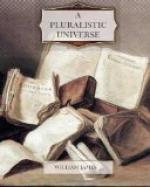Our ideal decomposition of the drops which are all that we feel into still finer fractions is but an incident in that great transformation of the perceptual order into a conceptual order of which I spoke in my last lecture. It is made in the interest of our rationalizing intellect solely. The times directly felt in the experiences of living subjects have originally no common measure. Let a lump of sugar melt in a glass, to use one of M. Bergson’s instances. We feel the time to be long while waiting for the process to end, but who knows how long or how short it feels to the sugar? All felt times coexist and overlap or compenetrate each other thus vaguely, but the artifice of plotting them on a common scale helps us to reduce their aboriginal confusion, and it helps us still more to plot, against the same scale, the successive possible steps into which nature’s various changes may be resolved, either sensibly or conceivably. We thus straighten out the aboriginal privacy and vagueness, and can date things publicly, as it were, and by each other. The notion of one objective and ’evenly flowing’ time, cut into numbered instants, applies itself as a common measure to all the steps and phases, no matter how many, into which we cut the processes of nature. They are now definitely contemporary, or later or earlier one than another, and we can handle them mathematically, as we say, and far better, practically as well as theoretically, for having thus correlated them one to one with each other on the common schematic or conceptual time-scale.
Motion, to take a good example, is originally a turbid sensation, of which the native shape is perhaps best preserved in the phenomenon of vertigo. In vertigo we feel that movement is, and is more or less violent or rapid, more or less in this direction or that, more or less alarming or sickening. But a man subject to vertigo may gradually learn to co-ordinate his felt motion with his real position and that of other things, and intellectualize it enough to succeed at last in walking without staggering. The mathematical mind similarly organizes motion in its way, putting it into a logical definition: motion is now conceived as ’the occupancy of serially successive points of space at serially successive instants of time.’ With such a definition we escape wholly from the turbid privacy of sense. But do we not also escape from sense-reality altogether? Whatever motion really may be, it surely is not static; but the definition we have gained is of the absolutely static. It gives a set of one-to-one relations between space-points and time-points, which relations themselves are as fixed as the points are. It gives positions assignable ad infinitum, but how the body gets from one position to another it omits to mention. The body gets there by moving, of course; but the conceived positions, however numerously multiplied, contain no element of movement, so Zeno, using nothing but them in his discussion, has no alternative but to say that our intellect repudiates motion as a non-reality. Intellectualism here does what I said it does—it makes experience less instead of more intelligible.




